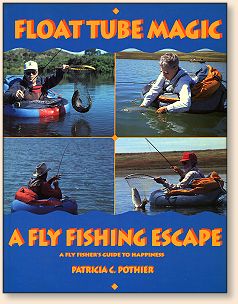|
Float tubers not infrequently catch large fish,
often in beautiful serene surroundings. Best of
all, they do it with an "affordable" boat in the
form of a float tube that can be stored in the
trunk of a car.
Perhaps you are a stream fisherman who is tired
of scrambling over rocks like greased bowling
balls to cast to waiting trout; walking miles up
and down hot dusty trails to get to a decent
fishing hole; battling dozens of other fly fishing
men/women and boats for casting space on your
favorite river; casting to avoid overhanging
willows. If this is true for you, then it's
time for you to consider stillwater fly fishing
from a float tube.
Another way to decide if float tubing is for you
is to imagine that you are actually having an
experience of float tube fly fishing. For just
a new moments place yourself in this scene:

You are sitting comfortably on a webbed seat in
your float tube on the clear waters of Duck Lake
just east of Glacier National Park in Montana.
There are a few threatening dark clouds to the
south, but just now it is clear and sunny with
just a slight breeze to riffle the water. The
snow-capped glacial mountains rise majestically
in the west from the valley basin. This is a
scene even a picture postcard cannot capture.
There is a very peaceful feeling about just being
able to float on the water and move about on your
own power.
Paddling backward with your fins, you are slowly
backing in an easterly direction, parallel with
the shore. You are following a line where the
shallow water drops off steeply to the next depth
of the lake. You know that this is a favored
feeding place for big trout. They dart from
the protection of deep water, grab food from the
shallows and escape to security again with a
minimum amount of energy.
You have been casting a size eight black artificial
leech with your sinking line. You let your fly slide
down the drop off and then retrieve it trying to
imitate the undulating movement of a leech in
search of its own food. No fish have been
interested in your fly for the past hour and
you are lulled into inattention by the warmth
of the morning sun and the beauty of the setting.
Suddenly, you wake from your dream-like state
to the welcome sound of your reel singing its
beautiful song as a large trout leaps through
the surface film some thirty feet away. You
raise your rod to set the hook. Your heart
pounds. A big trout has taken your fly. You
wonder if you will be able to bring it in. It
jumps two more times and you see its beautiful
red sides. Now, the trout is tiring and you
begin to cautiously reel it in. It is almost
to your tube now, but as you reach for your net,
the fish makes one more surge for freedom. You
let it run, then slowly bring it to your net one
final time. The trout's a beauty, perhaps four
or five pounds. Carefully, you remove the hook
from its jaw and suspend it gently in the water
moving the fish forward and backward until it
is ready to take off and return to the depths
of Duck Lake.

This is an experience that every float tube fly
fishing woman or man seeks and enjoys. This
can be your experience.
Float Tubing Evolves
You might wonder who invented the first float
tube and why. Nobody knows for sure, but
according to fishing lore, the idea for the
first float tube came from a bass fisherman
in Oklahoma about forty years ago and was later
perfected by fly fishing men and women in the
west, particularly in Idaho (Whitlock, 1992).
Perhaps the inspiration for using a float tube
arose when a fisherman was frustrated at not
being able to reach rising fish from the shoreline
and didn't want the expense and trouble of a boat.
These first tubes, referred to as belly boats, were
little more than an inner tube with a canvas covering
and a sling seat. Contemporary tubes are covered
with heavy duty nylon or vinyl coated canvas, with
back and arm rests, stripping aprons to hold
retrieved fly line, O rings and velcro for attaching
other pieces of gear such as nets and stringers,
pockets for all kinds of gear and, of course, fly
boxes. And some bright person came up with the idea
of using divers swim fins for propelling the tube
and to change directions, thus freeing the fly fisher
to concentrate both hands on the tasks of fishing.

Some of the reasons for the interest in lake
fishing are those described earlier about the
advantages of lake and the disadvantages of
stream fishing. An additional phenomenon that
might account for the popularity of stillwater
fishing from float tubes is the longevity of the
vast number of people who are dedicated to the
sport of fly fishing. When the spirit still want
to fish, but the aging body puts limits on capacity
and endurance, lake fishing becomes a reasonable
and satisfying alternate. There are women and men
in their 80s who are still tubing and enjoying
this unique octogenarian experience. ~ PCP
Credits: Excerpt from Float Tube
Magic By Patricia C. Potheir, published
by Frank Amato Publications. We appreciate use
permission.
|




